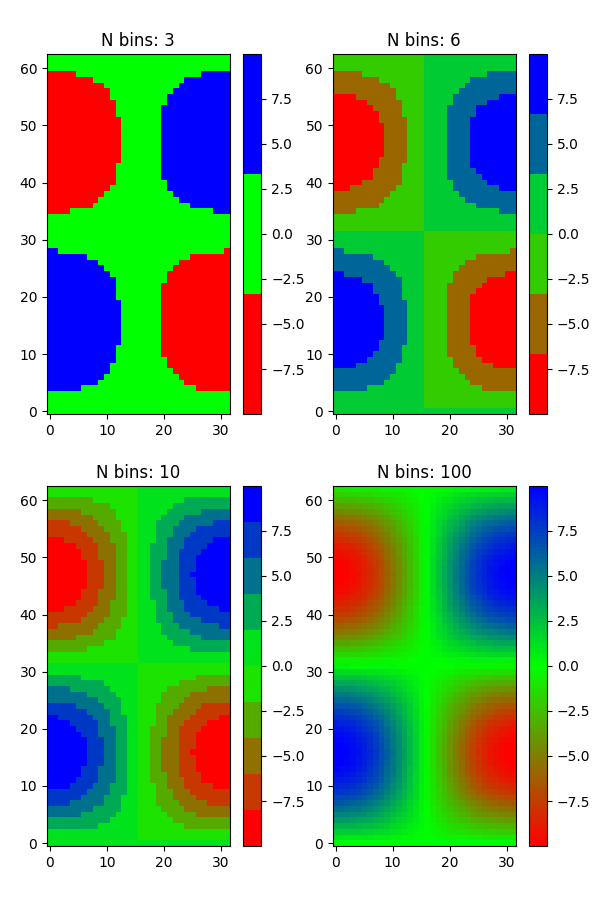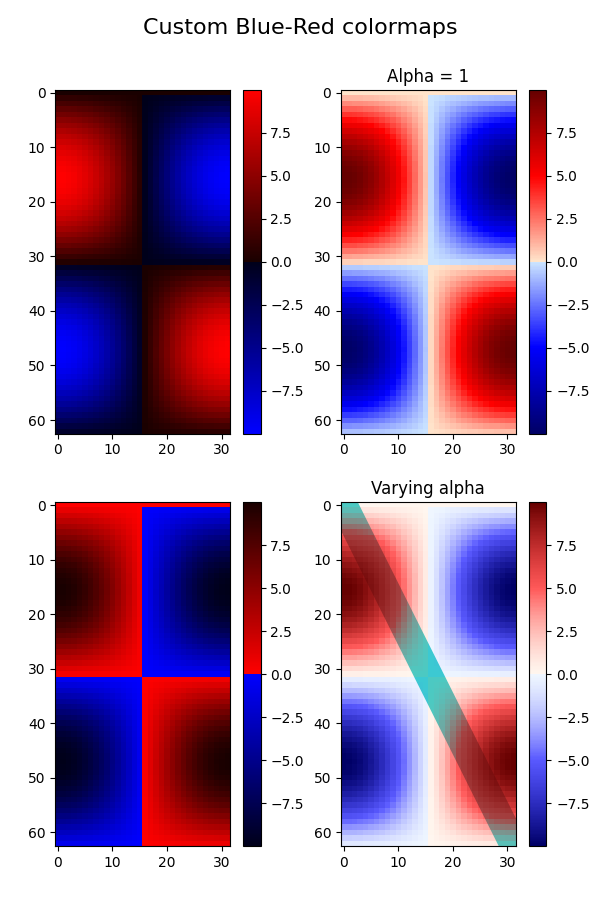从颜色列表创建颜色映射
有关创建和操作色彩映射的更多详细信息,请参阅在Matplotlib中创建色彩映射。
可以使用LinearSegmentedColormap的from_list()方法从颜色列表创建颜色映射。您必须传递一个RGB元组列表,用于定义从0到1的颜色混合。
创建自定义色彩映射
也可以为色彩映射创建自定义映射。 这是通过创建字典来实现的,该字典指定RGB通道如何从cmap的一端变为另一端。
示例:假设您希望红色在下半部分从0增加到1,绿色在中间半部分增加到相同,而在上半部分则为蓝色。 然后你会用:
cdict = {'red': ((0.0, 0.0, 0.0),(0.5, 1.0, 1.0),(1.0, 1.0, 1.0)),'green': ((0.0, 0.0, 0.0),(0.25, 0.0, 0.0),(0.75, 1.0, 1.0),(1.0, 1.0, 1.0)),'blue': ((0.0, 0.0, 0.0),(0.5, 0.0, 0.0),(1.0, 1.0, 1.0))}
如果在这个例子中,r,g和b组件中没有不连续性,那么它很简单:上面每个元组的第二个和第三个元素是相同的 - 称之为“y”。 第一个元素(“x”)定义了0到1整个范围内的插值间隔,它必须跨越整个范围。换句话说,x的值将0到1范围划分为一组段,并且y给出每个段的端点颜色值。
现在考虑绿色。cdict[‘green’]表示对于0 <= x <= 0.25,y为零; 没有绿色。0.25 < x <= 0.75,y从0到1线性变化.x > 0.75,y保持为1,全绿色。
如果存在不连续性,则会更复杂一些。将给定颜色的cdict条目中每行中的3个元素标记为(x, y0, y1)。然后,对于x[i] 和 x[i + 1]之间的x值,在 y1[i] 和 y0[i + 1] 之间内插颜色值。
回到指南里的例子,看看cdict[‘red’]; 因为y0!= y1,它表示对于x从0到0.5,红色从0增加到1,但随后它向下跳跃,因此对于x从0.5到1,红色从0.7增加到1.绿色斜坡从0开始 当x从0变为0.5时变为1,然后跳回0,当x从0.5变为1时,斜坡变回1:
row i: x y0 y1//row i+1: x y0 y1
以上是试图表明对于x[i]到 x[i + 1] 范围内的x,插值在 y1[i] 和 y0[i + 1] 之间。因此,永远不会使用y0[0] 和 y1[-1]。
import numpy as npimport matplotlib.pyplot as pltfrom matplotlib.colors import LinearSegmentedColormap# Make some illustrative fake data:x = np.arange(0, np.pi, 0.1)y = np.arange(0, 2 * np.pi, 0.1)X, Y = np.meshgrid(x, y)Z = np.cos(X) * np.sin(Y) * 10
—- 列表中的色彩映射 —-
colors = [(1, 0, 0), (0, 1, 0), (0, 0, 1)] # R -> G -> Bn_bins = [3, 6, 10, 100] # Discretizes the interpolation into binscmap_name = 'my_list'fig, axs = plt.subplots(2, 2, figsize=(6, 9))fig.subplots_adjust(left=0.02, bottom=0.06, right=0.95, top=0.94, wspace=0.05)for n_bin, ax in zip(n_bins, axs.ravel()):# Create the colormapcm = LinearSegmentedColormap.from_list(cmap_name, colors, N=n_bin)# Fewer bins will result in "coarser" colomap interpolationim = ax.imshow(Z, interpolation='nearest', origin='lower', cmap=cm)ax.set_title("N bins: %s" % n_bin)fig.colorbar(im, ax=ax)

—- 自定义色彩映射 —-
cdict1 = {'red': ((0.0, 0.0, 0.0),(0.5, 0.0, 0.1),(1.0, 1.0, 1.0)),'green': ((0.0, 0.0, 0.0),(1.0, 0.0, 0.0)),'blue': ((0.0, 0.0, 1.0),(0.5, 0.1, 0.0),(1.0, 0.0, 0.0))}cdict2 = {'red': ((0.0, 0.0, 0.0),(0.5, 0.0, 1.0),(1.0, 0.1, 1.0)),'green': ((0.0, 0.0, 0.0),(1.0, 0.0, 0.0)),'blue': ((0.0, 0.0, 0.1),(0.5, 1.0, 0.0),(1.0, 0.0, 0.0))}cdict3 = {'red': ((0.0, 0.0, 0.0),(0.25, 0.0, 0.0),(0.5, 0.8, 1.0),(0.75, 1.0, 1.0),(1.0, 0.4, 1.0)),'green': ((0.0, 0.0, 0.0),(0.25, 0.0, 0.0),(0.5, 0.9, 0.9),(0.75, 0.0, 0.0),(1.0, 0.0, 0.0)),'blue': ((0.0, 0.0, 0.4),(0.25, 1.0, 1.0),(0.5, 1.0, 0.8),(0.75, 0.0, 0.0),(1.0, 0.0, 0.0))}# Make a modified version of cdict3 with some transparency# in the middle of the range.cdict4 = {**cdict3,'alpha': ((0.0, 1.0, 1.0),# (0.25,1.0, 1.0),(0.5, 0.3, 0.3),# (0.75,1.0, 1.0),(1.0, 1.0, 1.0)),}
现在我们将使用此示例来说明处理自定义色彩映射的3种方法。首先,最直接和明确的:
blue_red1 = LinearSegmentedColormap('BlueRed1', cdict1)
其次,显式创建地图并注册它。与第一种方法一样,此方法适用于任何类型的Colormap,而不仅仅是LinearSegmentedColormap:
blue_red2 = LinearSegmentedColormap('BlueRed2', cdict2)plt.register_cmap(cmap=blue_red2)
第三,仅对于LinearSegmentedColormap,将所有内容保留为register_cmap:
plt.register_cmap(name='BlueRed3', data=cdict3) # optional lut kwargplt.register_cmap(name='BlueRedAlpha', data=cdict4)
制作图:
fig, axs = plt.subplots(2, 2, figsize=(6, 9))fig.subplots_adjust(left=0.02, bottom=0.06, right=0.95, top=0.94, wspace=0.05)# Make 4 subplots:im1 = axs[0, 0].imshow(Z, interpolation='nearest', cmap=blue_red1)fig.colorbar(im1, ax=axs[0, 0])cmap = plt.get_cmap('BlueRed2')im2 = axs[1, 0].imshow(Z, interpolation='nearest', cmap=cmap)fig.colorbar(im2, ax=axs[1, 0])# Now we will set the third cmap as the default. One would# not normally do this in the middle of a script like this;# it is done here just to illustrate the method.plt.rcParams['image.cmap'] = 'BlueRed3'im3 = axs[0, 1].imshow(Z, interpolation='nearest')fig.colorbar(im3, ax=axs[0, 1])axs[0, 1].set_title("Alpha = 1")# Or as yet another variation, we can replace the rcParams# specification *before* the imshow with the following *after*# imshow.# This sets the new default *and* sets the colormap of the last# image-like item plotted via pyplot, if any.## Draw a line with low zorder so it will be behind the image.axs[1, 1].plot([0, 10 * np.pi], [0, 20 * np.pi], color='c', lw=20, zorder=-1)im4 = axs[1, 1].imshow(Z, interpolation='nearest')fig.colorbar(im4, ax=axs[1, 1])# Here it is: changing the colormap for the current image and its# colorbar after they have been plotted.im4.set_cmap('BlueRedAlpha')axs[1, 1].set_title("Varying alpha")#fig.suptitle('Custom Blue-Red colormaps', fontsize=16)fig.subplots_adjust(top=0.9)plt.show()

参考
此示例中显示了以下函数,方法,类和模块的使用:
import matplotlibmatplotlib.axes.Axes.imshowmatplotlib.pyplot.imshowmatplotlib.figure.Figure.colorbarmatplotlib.pyplot.colorbarmatplotlib.colorsmatplotlib.colors.LinearSegmentedColormapmatplotlib.colors.LinearSegmentedColormap.from_listmatplotlib.cmmatplotlib.cm.ScalarMappable.set_cmapmatplotlib.pyplot.register_cmapmatplotlib.cm.register_cmap

